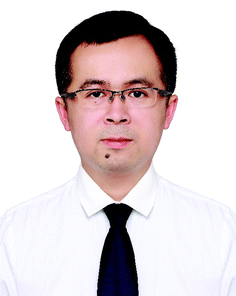Materials Horizons Emerging Investigator Series: Dr Jie Jiang, Central South University, China
Jie Jiang is an Associate Professor at the School of Physics and Electronics of Central South University. He obtained his BE degree (2007), ME degree (2009), and PhD degree (2012) from Hunan University. He was a Post-doctoral Fellow at Nanyang Technological University, Singapore (2012–2013) and Auburn University, USA (2014–2015). His research interests focus on neuromorphic photoelectric hybrid devices based on thin-film oxide and 2D semiconductor materials. He has published more than 50 papers as first author/corresponding author, which are often highlighted by NPG Asia Materials, MaterialsViews China, X-MOL, etc.
Read Jie Jiang's Emerging Investigator Series article ‘Polarization-perceptual anisotropic two-dimensional ReS 2 neuro-transistor with reconfigurable neuromorphic vision’ (https://doi.org/10.1039/D1MH02036F) and read more about him in the interview below:
MH: Your recent Materials Horizons Communication reports a polarization-perceptual neuro-transistor with a reconfigurable neuromorphic vision based on a 2D ReS 2 phototransistor and with excellent photodetection ability and superior intelligent polarization sensitivity. How has your research evolved from your first article to this most recent article and where do you see your research going in future?
JJ: Our first article was published over five years ago. In that paper, for the first time, we demonstrated an ion-modulated 2D MoS2 transistor for neuromorphic applications.1 After that work, we continuously developed the 2D MoS2 transistor for photoelectric and spatiotemporal 4D hybrid neuromorphic integration.2 We further reported a neuromorphic 0D–2D-mixed heterojunction phototransistor with enhanced performance using photo-sensitive quantum dots.3,4 However, up to now, the current photoelectric neuromorphic transistors were mostly based on the same photo-sensitive mechanism and new kinds of neuromorphic phototransistors still remain largely unexplored. Therefore, in this work, we would like to demonstrate the intriguing possibility of developing new devices. We noted that 2D ReS2 is an anisotropic polarization-sensitive material. That is to say, a polarization-sensitive neuromorphic device may be realized. If successful, we may create a new kind of neuromorphic device with powerful polarization-sensitive abilities. That is our motivation in this work. Therefore, in the near future, we anticipate device applications in polarization perception systems for intelligent humanoid robots and autonomous vehicles.
MH: What aspect of your work are you most excited about at the moment?
JJ: The most exciting achievement in this work is that we successfully developed a new neuromorphic phototransistor with polarization-perceptual abilities. It may open a new avenue for the development of next-generation intelligent perception systems in the future, such as autonomous navigation, bio-inspired medicine, and human–machine interaction.
MH: In your opinion, what are the most important questions to be asked/answered in this field of research?
JJ: In my opinion, the most important questions in this field of research are what the relations are between the underlying polarization physics and different neuromorphic applications, and how to develop a polarization-perceptual neuromorphic system toward intelligent humanoid robots, autonomous vehicles, etc.
MH: What do you find most challenging about your research?
JJ: The most challenging part is to improve the polarization-sensitive abilities due to the poor dichromic ratio in the current anisotropic polarization-sensitive materials.
MH: In which upcoming conferences or events may our readers meet you?
JJ: I usually attend the SPC and IEEE in China. However, due to COVID-19, I have attended hardly any recent conferences. I really hope that COVID-19 will be ending soon. If so, I will be glad to attend conferences to share my views and make good relationships with researchers at home and abroad.
MH: How do you spend your spare time?
JJ: I watch TV, or listen to music quietly.
MH: Can you share one piece of career-related advice or wisdom with other early career scientists?
JJ: I think that ideas and the full use of existing equipment are the two most important things.
References
- J. Jiang, J. Guo, X. Wan, Y. Yang, H. Xie, D. Niu, J. Yang, J. He, Y. Gao and Q. Wan, Small, 2017, 13, 1700933 CrossRef PubMed.
- J. Jiang, W. Hu, D. Xie, J. Yang, J. He, Y. Gao and W. Wan, Nanoscale, 2019, 11, 1360 RSC.
- Y. Cheng, H. Li, B. Liu, L. Jiang, M. Liu, H. Huang, J. Yang, J. He and J. Jiang, Small, 2020, 16, 2005217 CrossRef CAS PubMed.
- D. Xie, L. Wei, M. Xie, L. Jiang, J. Yang, J. He and J. Jiang, Adv. Funct. Mater., 2021, 31, 2010655 CrossRef CAS.
| This journal is © The Royal Society of Chemistry 2022 |

